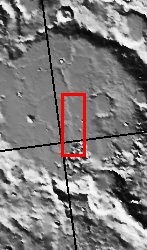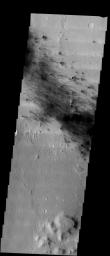
Released 11 June 2003
Yesterday, a Delta II rocket successfully lifted off from Cape Canaveral, Florida carrying the Mars Exploration Rover named Spirit. Its destination is a crater called Gusev in the southern hemisphere of Mars. This crater may have been the site of an ancient lake whose sediments could be sampled by Spirit. The THEMIS image covers a portion of the center of the elliptical region in which the rover is expected to land nearly seven months from now. The scene contains wispy dark streaks that probably arise from the removal by wind of a layer of bright dust. Just to the south of the dark streaks is a boundary that may represent the edge of a layer of material that has flowed in from the south. With luck, Spirit will have access to a variety of interesting rock types and terrains that will settle the question of whether Gusev crater hosted a lake.
Image information: VIS instrument. Latitude -14.7, Longitude 175.5 East (184.5 West). 19 meter/pixel resolution.
Note: this THEMIS visual image has not been radiometrically nor geometrically calibrated for this preliminary release. An empirical correction has been performed to remove instrumental effects. A linear shift has been applied in the cross-track and down-track direction to approximate spacecraft and planetary motion. Fully calibrated and geometrically projected images will be released through the Planetary Data System in accordance with Project policies at a later time.
NASA's Jet Propulsion Laboratory manages the 2001 Mars Odyssey mission for NASA's Office of Space Science, Washington, D.C. The Thermal Emission Imaging System (THEMIS) was developed by Arizona State University, Tempe, in collaboration with Raytheon Santa Barbara Remote Sensing. The THEMIS investigation is led by Dr. Philip Christensen at Arizona State University. Lockheed Martin Astronautics, Denver, is the prime contractor for the Odyssey project, and developed and built the orbiter. Mission operations are conducted jointly from Lockheed Martin and from JPL, a division of the California Institute of Technology in Pasadena.

 Planetary Data System
Planetary Data System













